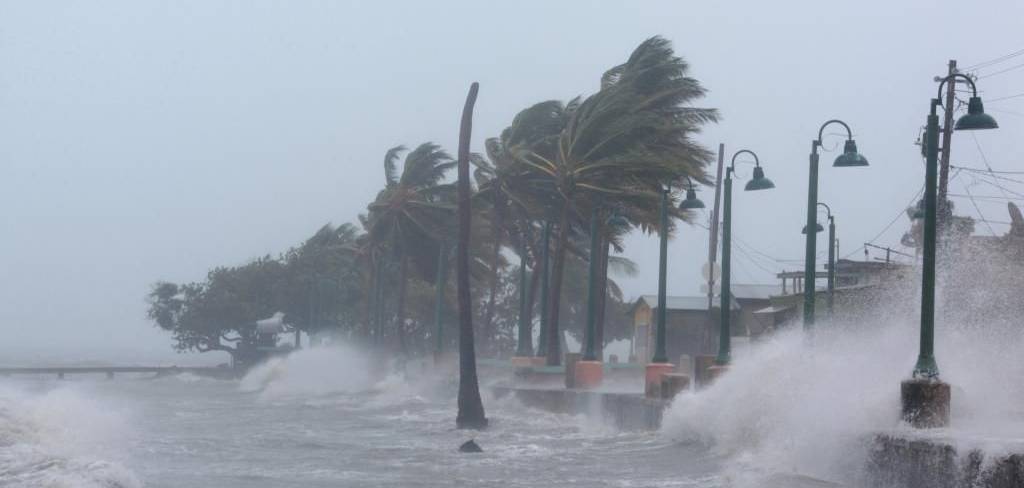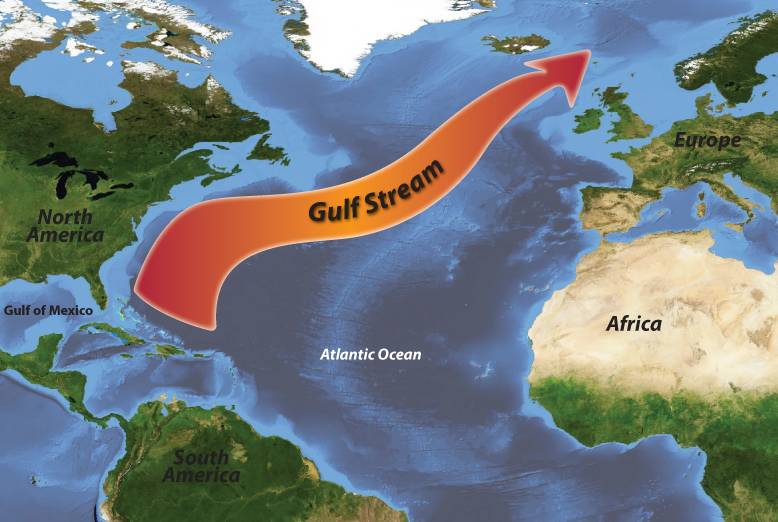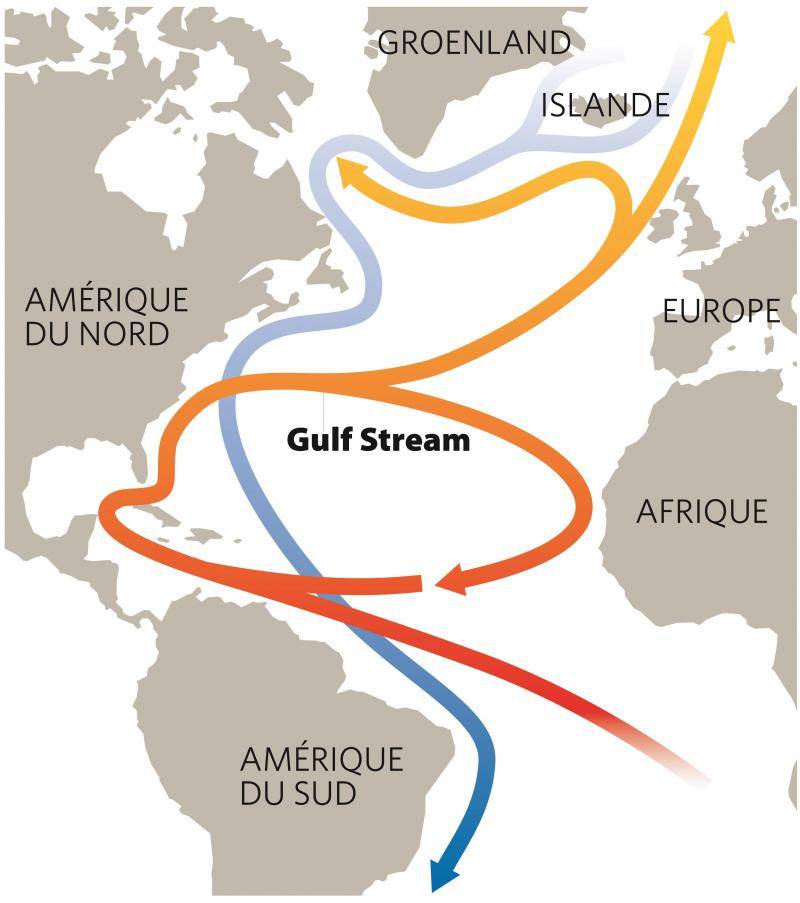
A recent report published in the journal Nature Geoscience reveals a weakening of the Gulf Stream to a level not seen for 1000 years. What does that mean ? Should we be worried about it? And first of all, what is the Gulf Stream?
As its name suggests, The Gulf Stream is a current. Located in the Atlantic, this oceanic current finds its point of departure in the region of Florida to go up to Greenland.

As shown in the image below, the Gulf Stream works like a giant conveyor belt, carrying warm surface water from the equator northward and returning cold, low salinity water deep south. “ It displaces nearly 20 million cubic meters of water per second, or nearly 100 times the flow of the Amazon River, ” explains Stefan Rahmstorf, scientist and co-author of the study.

The mode of operation of these two marine flows is relatively easy to understand. It is mainly explained by the temperature and the salt density. The current going from South to North is hot while that going in the opposite direction is cold. Warm (lighter) water stays on the surface while cold (heavier) water sinks into the ocean. As for salinity, our science lessons have taught us that the more water is loaded with salt, the more dense it is. It will go naturally to the bottom, due to its heavier weight. So, to sum up, hot, salty water moves from south to north where it cools and thus becomes more dense. When it is heavy enough, water flows to deeper ocean layers and returns to the south.
In more elaborate terms, oceanographers call North Atlantic drift, the mass appeal from the South created by the difference in temperature and salinity. We will also talk about the marine current system of the Atlantic basin, or AMOC in English (Atlantic Meridional Overturning Circulation) or thermohaline circulation (thermo for temperature and haline relating to marine salinity)
What is the use of this current? Why is it so important to our planet?
The Gulf Stream allows heat transfer between the poles and the equator. Without it, the temperature difference between the equator and the poles would be much greater.
Once these natural phenomena have been explained, why is the scientific community so worried?
As the name suggests, a current is a flow. This flow has a circulation speed. He must maintain a constant and naturally elevated pace to fulfill his office. Now, this is where the problem arises. Researchers have established that this current is weakening. He slows down. If we are to believe the Nature Geoscience report , it would even be at its lowest level for 1000 years! With the help of the study of the size of the grains in the cores of oceanic sediments (so called because of the shape recalling that of a carrot, which the machine which is used to make the pre-vents in the bottom, gives to the samples ), readings of atmospheric temperatures and surface water or the composition of coral species among others, scientists are able to determine the strength of the current and therefore its speed. Certainly, losses of speed have already occurred in the past at various ages in the evolution of our planet, but certainly never in such a proportion.
What is the cause of this slowdown?
If we resume our course in physical science, the explanation is simple. The ice at the poles is melting and releasing millions of tons of fresh water into the ocean. The consequence of this is to lighten the ocean water, to disrupt the circulation of flows and to slow down the meridian circulation of the Atlantic reversal. In other words, the salinity is diluted, the water becomes less dense, therefore lighter and therefore cannot reach the deep layers to start again in the other direction. The mechanism seizes up.
In what way what has been observed by scientists represents a danger for us?
The threats to the populations on both sides of the Atlantic are real and serious. The computer models carried out are the ideal scenario of a disaster film in the long term and are cold in the back.
Levke Caesar, lead author of the study, explains the consequences: “ The surface flow of the AMOC to the north causes a deviation of water masses to the right, away from the east coast of the United States at cause of the Earth's rotation "" As the current slows down, this effect weakens and more water can collect on the east coast of the United States, leading to increased sea level rise " . Stefan Rahmstorf adds: “ We can clearly see that a specific area of the North Atlantic has been cooling for a century while the rest of the planet is warming. Previous research had already shown that slowing thermohaline circulation could be the cause. Now, we have detected strong signs: the overall transmission belt has indeed lost its vigor over the last century, and more particularly since 1970 "
Therefore, the consequences are clearly identified and not very encouraging:
- An abrupt change in temperature. Term given by scientists to mention a clear cooling over the North Atlantic. The results obtained using a new algorithm indicate catastrophic proportions.
- more marked climatic extremes with harsher winters and drier and hotter summers.
- an acceleration of extreme weather events.
- intensification of wetlands and drylands
- the extension of deserts towards the poles of the two hemispheres.
- intensification of hurricanes and worsening weather conditions
- the rise in water level on both sides of the ocean, drowning entire regions.
- The disruption of the oceanic storage of CO².
- The upheaval of agriculture,
- The endangering of ecosystems.
An essential question remains unanswered: why do the ice creams melt?
The answer would become almost heartbreaking banality: because of rising temperatures due to human-induced global warming. If we do nothing or do not do enough to reverse the trajectory, we are headed for disaster. As Stefan Rahmstorf rightly warns: “ If we continue to fuel global warming, the Gulf Stream system will weaken further - from 34 to 45% by 2100, according to the latest generation of climate models. This could bring us dangerously close to the tipping point at which the flow becomes unstable ”.
Posted on 2021-03-05 16:38








Comments